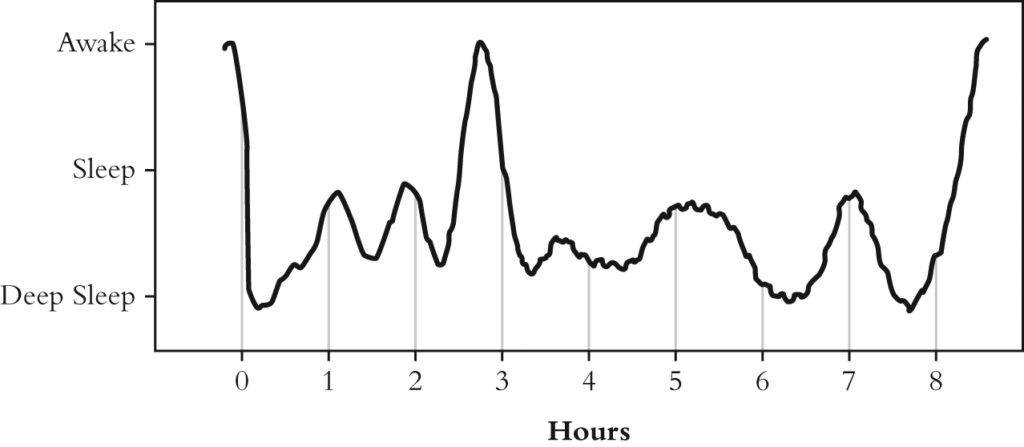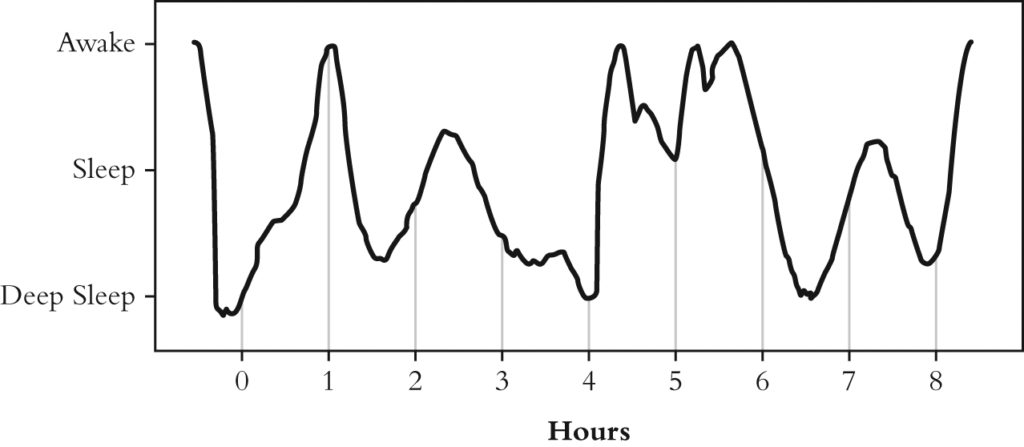Over time using the Transition Trek, you will develop the skills necessary to get to sleep quickly and reliably. I have done my best to relay to you all the research I have done and the experiences others and I have had through the decades. Figure 10-1 shows my sleep cycles for a good night’s sleep.
Figure 10-1 A Good Night’s Sleep – Sleep Cycle iPhone App
To get this curve, I used an inexpensive iPhone app called “Sleep Cycle” that measures body movement using the iPhone accelerometer. It isn’t all that accurate, but it did provide a good indication of the times I was awake: at the beginning, once during the night, and at end. Just before 3 am, I woke and went to the bathroom. The rest of the time, I stayed asleep. The small humps occurred when my sleep was not so deep and probably signify REM, although Sleep Cycle has no way of measuring REM.
Occasionally, I do still have a bad night’s sleep, as shown in Figure 10-2. I didn’t think I had slept much the entire night, but as you can see, I did get a good measure of sleep. I repeatedly used the Transition Trek successfully, but for some reason I spent more time in REM, hypnopompia and hypnagogia. I was restless. However, even after one of those nights, the following day isn’t problematic because I sleep so much on other nights. Plus, I have learned not to have such a bad attitude when I have spent more time at the edges of sleep rather than in deep sleep.
Figure 10-2 A Bad Night’s Sleep – Sleep Cycle iPhone App
Generally, I now just step into my Transition Trek, and a few steps down the path, I am asleep. Sometimes I can just wave the trek in front of my mind’s eye, so to speak, and I go to sleep. The solution seems to go beyond just successfully getting to sleep. It seems to be remaking my entire sleep landscape. The quality of sleep seems better, and I have more difficulty remembering my dreams, another indication of deeper sleep. Plus, I am more emotionally stable. Perhaps all that time during the night that I spent worrying, trying to solve problems and carrying on imaginary arguments, was emotionally abusive and spending more time sleeping instead of quarreling within myself has brought my emotional and intellectual perspective closer to reality.
I have found all the Transition Treks to be an increasingly effective method of getting to sleep. As I have mentioned before, at first using the Coastal Transition Trek, I was going all the way through to the cave and even entering Chasing Hypnos. But gradually, the time it took to fall asleep grew shorter. I started falling asleep before I made it to the cave and ate dinner. Generally, I made it to the lake but not the cliff on the other side. Then, I got to where I didn’t make it to the top of the first hill. Sometimes, I barely got the boat onshore. And then I had what were for me really unusual experiences. I would just start the Transition Trek and fall asleep. I even had a few times when I just thought of using the Transition Trek, and I was already asleep. I have had times when I have fallen asleep in as little as five or ten seconds.
I know this sounds incredible to someone staying awake for hours before sleep overtakes him or her, as I once did, but it is true. Of course, I also have had setbacks. Sometimes they occur when I first get in bed, and at others they are when I wake during the night. But those setbacks occur during difficult times and still last only ten or fifteen minutes. They are the exceptions and are caused by specific worries or unusually exciting life events or physical states like illness or injury. I now have control of my sleep habits, and believe me, it is certainly nice to get as much sleep as I need practically every night.
Let me reinforce the fact that the Transition Trek method is not a trick used to get to sleep. This method is built on a scientific understanding of the psychic reality of hypnagogia and hypnopompia and the mind’s basic imaging nature. When something goes wrong, when you have an overriding issue that your mind can’t set aside to view Transition Trek images, at least you will recognize the problem. Family health issues, injury or a major problem at work can still, and sometimes will, override the Transition Trek. Just stay with it. It won’t be until your propensity to sleep overcomes your need to consider the issue that you will be able to focus on the images of the Transition Trek and drop off. It only takes a few minutes to overcome practically every issue you will encounter.
You now know better than anyone what is going on inside your own mind while you are going to sleep. You know how universal the experience is and what can go wrong. More specifically, you may be able to backtrack to learn what went wrong to begin with that produced your insomnia. And since you are the only one who has access to what is going on inside you, you are the expert on yourself. You can now evaluate your sleep problems as they arise and investigate solutions. In doing so, you have taken control of your own mental processes that lead to sleep. You can even solve problems before they start affecting sleep. All of us need professional help from time to time, and if you do run into trouble, you have that option. It is no longer your only option.
*
As we come to the end of this book on pursuing sleep, we should look back on what we have learned. We have learned how complex and interesting these states (hypnagogia and hypnopompia) are. We know hardly anything about them from scientific research and must rely on what we discover for ourselves. Other cultures spend more time with these states and use them to their benefit. Yet, we try to minimize them, so we can get on with the productive parts of our lives. Generally, these are about the goals of a company and have little to do with us personally. We work for a salary. Coming from the standpoint of someone who spent decades in aerospace working on space projects, I now realize that my entire existence was structured by what a corporation wanted from me rather than me structuring my own life around what I wanted and needed as a human being. I didn’t even have time to think my own thoughts. I thought what a corporation wanted me to think about. I slept during hours that would be conducive to my being ready to work the next day. Things like hypnagogia and hypnopompia were of no significance and had no purpose. But these states are a part of life. They can be a big part of life for someone who is interested in their lives as individuals and not a part of a corporation.
Those of us who have difficulty sleeping may have been given a gift. We may have insomnia because our lives are speaking to us. We should at least pay attention to it at times to reap the rewards gained from observing these alternate states of consciousness. As individuals we are involved in a human experience that we are trying to stamp out. If we used hypnagogia for the creative, spiritual, problem-solving, and entertaining experiences they were intended to be, we might be much happier. Experts often say that they don’t know why we sleep. They do know that it is crucial to staying healthy and alive. By staying out of hypnagogia and hypnopompia, you may be missing a big portion of your life. But until we study these esoteric states and learn how to use them, we do need to control them so that they don’t have such negative influences on our lives. Once we come to terms with these states, we might be happier and more productive. Perhaps even our siesta time should be a productive part of our work day. In that way we can harness our psychic energies for our personal, public and professional lives.
I want to repeat something I said back in the Author’s Note: Nothing is wrong with you. When you were born, you did not have a sleep birth defect. You don’t need medication to sleep. What you do need is a little help with the way your thoughts go off the rails during hypnagogia and hypnopompia. Scientists may not yet know why we need to sleep, but we do intuitively. That one-third of our lives is what makes the other two-thirds work.


